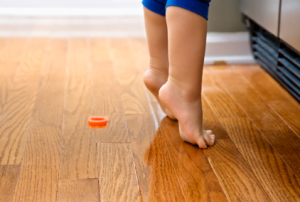A Healthier World with Wood
 Unlike most floor coverings, wood floors come from a natural resource that is sustainable. Long gone are the days when timber was cut down with little thought for the long term consequences on the nation’s forests. Today most timber is cut from forests that are carefully managed to ensure continued resources in the future. In fad, according to U.S. Forest Service statistics, almost twice as much hardwood timber is added every year through new growth as is harvested. Additionally, there is more standing hardwood timber today than there was 50 years ago. Consumers who want additional reassurance that their wood floors are from a sustainable managed forests can make sure their floors come from a certified wood flooring manufacturer. Certified manufacturers have verification from an independent agency such as Smart Wood (802/434-5491) that their timber is coming from sustainable managed forests.
Unlike most floor coverings, wood floors come from a natural resource that is sustainable. Long gone are the days when timber was cut down with little thought for the long term consequences on the nation’s forests. Today most timber is cut from forests that are carefully managed to ensure continued resources in the future. In fad, according to U.S. Forest Service statistics, almost twice as much hardwood timber is added every year through new growth as is harvested. Additionally, there is more standing hardwood timber today than there was 50 years ago. Consumers who want additional reassurance that their wood floors are from a sustainable managed forests can make sure their floors come from a certified wood flooring manufacturer. Certified manufacturers have verification from an independent agency such as Smart Wood (802/434-5491) that their timber is coming from sustainable managed forests.
Wood floors are produced with an efficient manufacturing process that wastes very little material. Oftentimes, byproducts such as wood dust are used to generate heat or electricity at the flooring mill. In addition, producers of engineered wood flooring make maximum use of lumber materials by using various grades of lumber for the different layers in the flooring… Once in the home, wood floors not only improve the structural integrity of the building but are one of the best insulating materials, helping to conserve energy resources.
Carpets Can Damage Your Health
 The hidden dangers of carpets have been revealed by environmental engineers who warn that the concentration of pollutants is up to 10 times higher in homes than outdoors. “If truckloads of dust with the same concentration of toxic chemicals as is found in most carpets were deposited outside, these locations would be considered hazardous waste dumps,” said John Roberts, who has studied the problem for nearly 20 years. He has found that on average a 10-year-old carpet will contain 21b (900g) of dust, much of it made up of dangerous substances, including heavy metals such as lead, cadmium and mercury, pesticides, and carcinogenic polycyclic aromatic hydrocarbons (PAHs) and polychlorinated biphenols (PCBs).
The hidden dangers of carpets have been revealed by environmental engineers who warn that the concentration of pollutants is up to 10 times higher in homes than outdoors. “If truckloads of dust with the same concentration of toxic chemicals as is found in most carpets were deposited outside, these locations would be considered hazardous waste dumps,” said John Roberts, who has studied the problem for nearly 20 years. He has found that on average a 10-year-old carpet will contain 21b (900g) of dust, much of it made up of dangerous substances, including heavy metals such as lead, cadmium and mercury, pesticides, and carcinogenic polycyclic aromatic hydrocarbons (PAHs) and polychlorinated biphenols (PCBs).
“The carpet is the largest reservoir of dust in a house, so that a house with bare floors and a few area rugs will have about one-tenth of the dust found in a house with wall-to-wall
carpet, ” Mr. Roberts said.
Contaminants are brought in by pets or on shoes and then become trapped in carpet fibers., Cooking fumes, dust mites, mold, Cigarette smoke and residues of food spills all exacerbate the problem. Cleaning chemicals only help mask carpets inherent problems; and leave unhealthy chemical residues that attract further dirt and cause discoloration.
Of all family members children face the greatest risks because they often play on the floor and then put their hands in their mouths. They inhale 23 times as much air as adults, weight for weight and can be damaged by even low levels of toxins_ Studies conducted across the country have suggested that the average infant ingests 110 namo-grams a day of the PAH benzopyrene – the equivalent of three cigarettes.
The Facts About: DERMATOPHAGOIDES A. K. A The DUSTMITE
- Dust mites survive by eating dead skin cells, which make up 80% of house dust.
- Dust mites live off water vapor, which is provided through perspiring and breathing.
- Dust mites are 0.3 mm in length and are related to Arachnids or Spiders.
- The dust mite life span lasts between 3-4 weeks; during which time 20 fecal pellets and 1 egg are created per day per mite.
- 1 Gram of dust (`/2 a teaspoon) will contain 1000 dust mites.
- Dust mites and skin cell shedding are two of the creepy on going necessities of life that we just do not like to think about. The fact that we spend our entire life shedding dead skin cells and dust mites spend their entire lives eating dead skin cells; might indicate that these are two subjects that we have to think about. The one area of our lives where we come in greatest and closest contact with dust mites is in the bedroom; which is where we spend 1/3 of our entire lives. The average bed of over a year old will have between I and 2 MILLION living dust mites. While sleeping at night a person can expect to move/toss 60 times, this in turn will cause dried dust mite dropping to be inhaled. It is the proteins that are in the fecal pellets that are being introduced directly into the lungs, which are at the root cause of up to 30% of asthma cases.
Washing all bed linens at least once a week will help reduce direct contact with the dust mites. Pillows should never be used for more than 2 years, and should be cleaned several times during that period of use. Mattresses should be cleaned a minimum of 1 per year by either: Applying Benzyl Benzoate (according to product directions), raising the bed temperature to 140 Degree F for over I hour or by using powerful vacuum for at least 20 minuets with a water filter ( or dust extraction) system. By using a regular vacuum the dust mites and other finer particles will be thrown back into the room and resettle.
Living Healthy
 The EPA has said that indoor air quality is one of our top health threats. Installed in the home or elsewhere, wood floors help contribute to a healthy living environment. Hard surface flooring such as hardwood floors does not trap or harbor dust mites and molds_ That creates better air quality for all inhabitants, but especially for the estimated 35 million who suffer from allergies. The hard surface of wood floors also helps avoid artificial substances such as pesticides that can accumulate on some floor coverings_ A recent EPA study found that pesticides used in gardens and homes accumulate on floors, but that wood floors greatly reduce the accumulation of such toxins. Another concern for the home environment is the of gassing of toxins that results from some synthetic materials. Any of these chemicals can make people in the home chronically ill.
The EPA has said that indoor air quality is one of our top health threats. Installed in the home or elsewhere, wood floors help contribute to a healthy living environment. Hard surface flooring such as hardwood floors does not trap or harbor dust mites and molds_ That creates better air quality for all inhabitants, but especially for the estimated 35 million who suffer from allergies. The hard surface of wood floors also helps avoid artificial substances such as pesticides that can accumulate on some floor coverings_ A recent EPA study found that pesticides used in gardens and homes accumulate on floors, but that wood floors greatly reduce the accumulation of such toxins. Another concern for the home environment is the of gassing of toxins that results from some synthetic materials. Any of these chemicals can make people in the home chronically ill.
